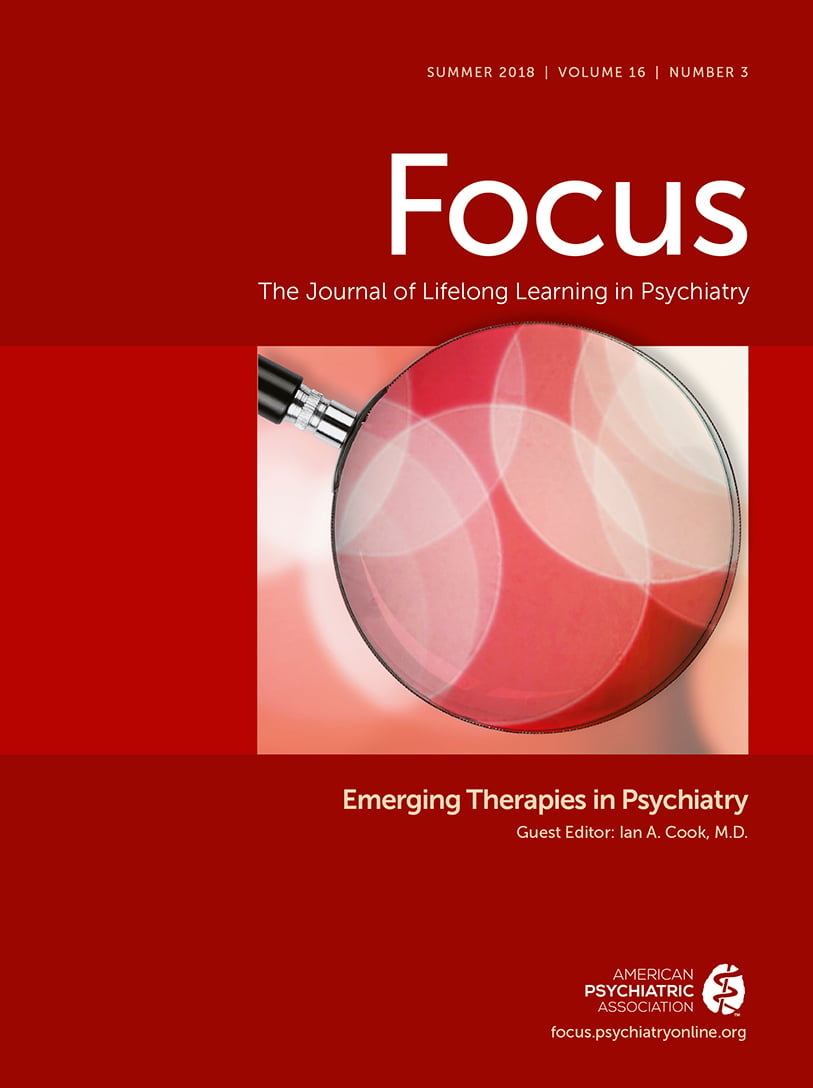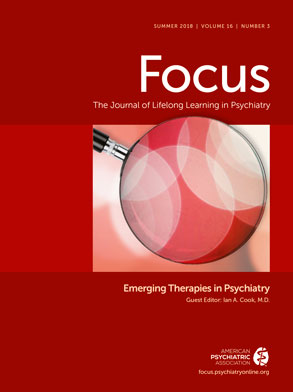Words are, of course, the most powerful drug used by mankind.
–Rudyard Kipling
For many patients with serious psychiatric disorders, current pharmacotherapies and psychotherapies remain ineffective, only partially effective, or poorly tolerated. Emerging therapies target treatment-resistant or treatment-intolerant patients and include interventional brain stimulation techniques to modulate dysfunctional brain circuitry (e.g., deep brain stimulation or vagal nerve stimulation); investigational neurochemical techniques (e.g., ketamine infusion); artificial intelligence-driven health tools, virtual reality, and other technologically facilitated treatment methods, among others. These therapies are in the investigational stages of determining safety and effectiveness. Patients seeking these interventions need to provide informed consent and understand the risks and potential benefits of experimental interventions (
1,
2).
Informed consent is one of the most important aspects of research ethics. The three essential elements of informed consent include voluntarism, information disclosure, and decision-making capacity. Voluntarism is “the ability of an individual to judge, freely, independently, and in the absence of coercion, what is good, right, and best subjected to his/her own situation, values, and prior history” (
3, p. 160). Voluntarism may be compromised by the very illnesses that compel one to seek this treatment: poor functioning, impaired judgment, and despair. Although the institutional review board (IRB) that approves the research addresses the issue of voluntarism, optimal involvement of patients in decision making is required to ensure that consent is truly voluntary (
4,
5).
Information disclosure refers to providing information that is necessary for a patient to make an informed decision about treatment:
For a valid consent, information provided to a research subject should include, but is not limited to, the health condition for which the research is proposed; nature and purpose/reason of the study; study treatment or intervention and experimental procedures; probable risks and benefits associated with research participation; nature of illness and possible outcome if the condition is left untreated; availability, risks and benefits of alternative treatments; right to withdraw at any time; and any other information that seems necessary for an informed decision to be taken by the patient. (
5, p. 27)
Researchers have attempted to improve the informed consent procedure by providing enhanced informed consent forms, which provide information in lay terms or may include decision aids such as videos, interactive web programs, or printed material (
6). However, these techniques often do not improve the participants’ understanding. What has been demonstrated to be most effective for ensuring understanding of the research risks and benefits is provider-participant interaction. A clear and open consent discussion includes asking the consenting individual to review what he or she has been told and assessment of the individual’s understanding (
3,
7,
8).
The last essential component of informed consent is the individual’s decision-making capacity. For a person to have the capacity to consent, he or she must understand the information, have a realistic appreciation of the situation, be able to use rational methods to decide, and be able to communicate a voluntary choice. Pediatric patients and cognitively impaired individuals may be unable to provide informed consent. A legal guardian or guardian ad litum may participate in the informed consent procedure in compelling situations where the treatment is indicated (
9–
12). An educational interactive discussion about the required informed consent elements with explanations adjusted by the provider to the person’s individual needs and health literacy level is recommended (
13). Informed consent is a dynamic and ongoing process during the research to ensure that the individual continues to understand and desire to remain in the research protocol.
Clinical Vignette
Mr. Potter entered the office. The research assistant, primary investigator physician, and nurse were all waiting for him, and each shook his hand as he took his seat. His anxiety was palpable. Ever since his wife had died the year before, the 59-year-old man had descended into his worst depression ever. Previously, he had responded to SSRIs. Now, he had failed multiple trials and was feeling helpless, hopeless, and with waves of suicidal impulses. He decided to take his psychiatrist’s recommendation and seek ketamine treatment.
Mr. Potter was a bright man with a blue-collar job. His depression had taken a toll on his sleep, appetite, motivation, and alertness. He had missed the last two weeks of work, and he felt he had to do something quickly to feel better, or he might lose his job. He was ready to say yes to almost anything that held the promise of feeling better. He articulated when he came in to the office, and insisted that he did not require the full, extensive discussion about informed consent.
Dr. Smith smiled empathically. “You sound desperate for help. We’re glad you are here, and we hope to be able to help you. But, this is still a research-based treatment. We want to be sure that you understand the treatment and want it. The more you understand and are in control, the more comfortable you will be. By the way, feeling in control helps depression, too. Let us review the treatment and the process. We will have time for discussion and questions. We also have handouts about the study. If you want to review those or talk it over with friends or family afterwards, that is okay, too.”
Mr. Potter nodded and said he would hear them out. After a brief video demonstrating the hypothesized mechanism of action of the drug, Dr. Smith reviewed the protocol. She explained what to expect in detail. Dr. Smith reviewed potential adverse reactions, referring to their handout. She also reviewed other possible treatments, such as medication, electroconvulsive therapy or transcranial magnetic stimulation. “Do you have questions?” Dr. Smith asked.
“No, I understand,” Mr. Potter assured them.
“Good,” Dr. Smith responded. “I noticed that you paid close attention. Sometimes we go into medical-speak jargon, and maybe we aren’t as clear as we want to be. Can you review with us your understanding of what the plan is? You know—just in your own words, without our medical-speak. That way, we are sure that we are all on the same page.”
Mr. Potter squinted as he tried to recall, noting, “I’m not as sharp as I used to be.” Then he summarized the mechanism of action, the plan for infusion, and the risks and benefits of the treatment in good detail. Afterward, he smiled and looked relieved. “Oh, do I need to have someone drive me here? Can I just take an Uber?” The need for monitoring was reviewed, and options were given.
“Okay, I really do understand now,” Mr. Potter mused. “Thanks for taking the time—even if I didn’t want to. I’m much less nervous now.” Mr. Potter signed the consent form and made an appointment for the first infusion. His goodbye handshake was much firmer than his handshake at the beginning of the appointment.
Communication Tips.
The following are communication tips for psychiatrists when providing informed consent for emerging treatments (
7,
13):
1.
Know the Research
A.
Involvement in the administration of emerging treatments requires a solid knowledge base of this treatment, as well as other alternative treatments—and the risks and benefits of all.
B.
Practice explaining the treatment to a friend or family member who is not a medical professional to solicit feedback about how clear it is for a lay person.
C.
Keep up with any new data or publications about the treatment—both positive and negative.
2.
Ensure Volition
A.
Is the patient voluntarily seeking this treatment? Are there any aspects of coercion—by prior treaters, family, research staff, or others? Is the individual feeling so frightened by the diagnosis that they would consent to any procedure and are not hearing potential risks? Review the patient’s motivation for seeking this treatment in a nonjudgmental manner. Listen carefully for hints that the patient feels pressured or desperate, and address this directly.
3.
Information Disclosure
A.
Most consent forms are reminiscent of user agreements on the Internet—several pages of information in small print, and most people just select “agree” and move on without reading or understanding to what they have just agreed. Review your forms and the language of the forms to ensure that they are as user-friendly as possible. Avoid jargon when possible.
B.
Leave plenty of time for the informed consent process—many individuals will want to just consent, but ensuring true understanding, engagement, and openness will be essential to the ethical, as well as practical, aspects of the treatment.
C.
Consider simple materials to aid the discussion, such as a cartoon-labeled brain with a proposed mechanism of action. Collaboratively reviewing materials may ensure that no major points are missed and can allow an assessment of understanding.
D.
If possible, have the patient accompanied by a trusted loved one—for support and for ongoing discussion about the treatment plans.
E.
Give plenty of time for questions and discussion. Consider having the patient “teach-back” or review with you what was just discussed in their own words. That will help identify any misperceptions.
F.
Set the stage (and the time) for ongoing questions and concerns during each visit for treatment.
4.
Assessment of Decision-Making Capacity
A.
Does the patient understand the information provided? Do they understand the purpose of the research, risks associated with the research intervention, obligations and consequences of research participation, and his or her right to withdraw consent at any time? Inquire about each of those, with teach-back, as appropriate.
B.
Some individuals require more time to consider options and review materials (including with significant others or a primary care physician). Suggest that for individuals that may seem pressured or uncertain.
C.
For individuals that may have cognitive limitations or lapses in reality-testing, ensure that they are capable of making decisions for themselves. If there are concerns, consider a guardian ad litum.
D.
Consent for underage minors requires extensive IRB review. Ensure that the guardian is fully aware and consenting. Assent and as much informed consent as possible should be provided for the child.
5.
Ensure an Appropriate “Holding Environment”
A.
Check-ins with the patient should occur regularly to enable learning about patient comfort and feelings of trust and safety in the treatment environment. Be sure to identify a point person whom the patient gets to know well, as well as a back-up for any questions or concerns.

